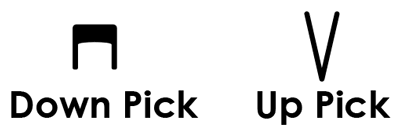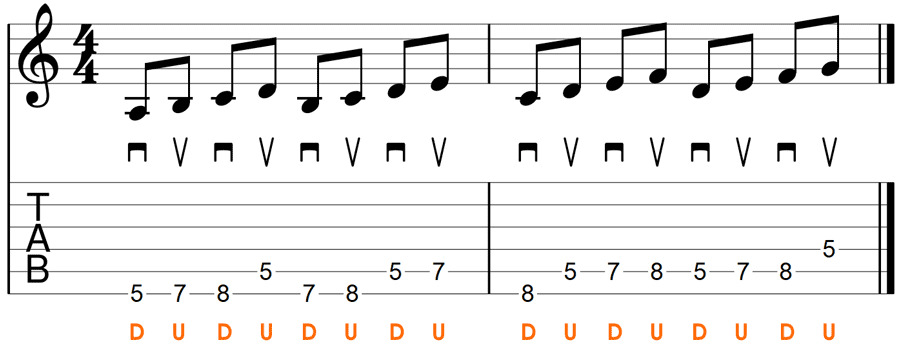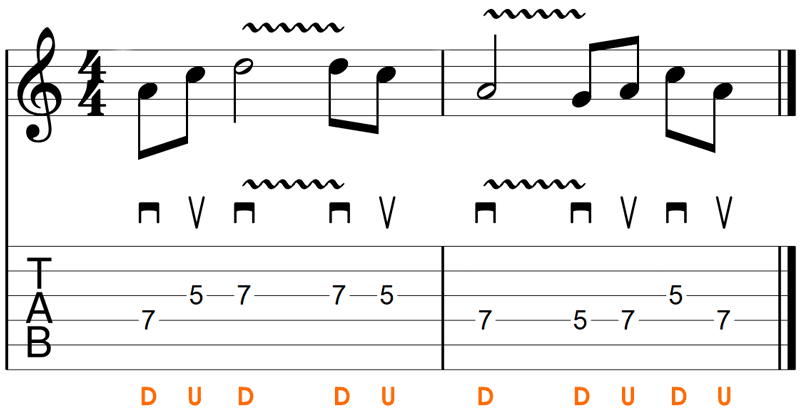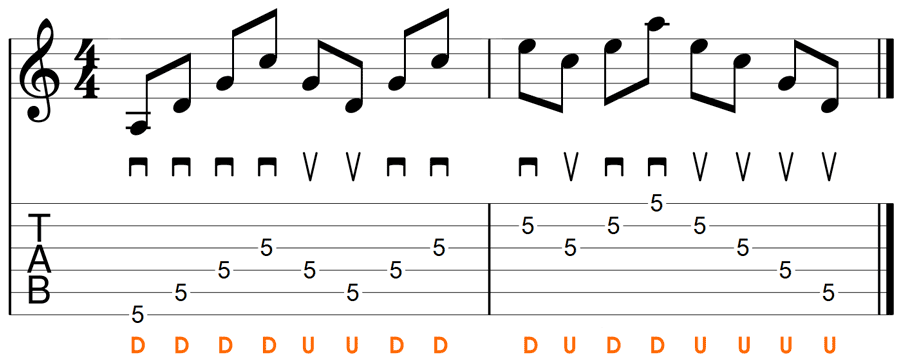There are a few different picking styles you can use on guitar and each picking style feels very different.
The picking styles you use play a big part in how comfortable something feels to play and how you sound.
In this guide, let’s go through all the main guitar picking styles so you can figure out which ones you should learn and when to use each picking style.
Picking Styles in Guitar TAB
The examples used in this guide use Guitar TAB as well as Standard Notation.
Here are the symbols used to indicate different picking directions:

While a lot of Guitar TAB or sheet music don’t use any picking symbols, I’ll use these in this guide to make it easier to understand each picking style.
When you have a song transcription or TAB that doesn’t include picking direction, you need to figure out which picking style to use. This guide will help you figure out which picking styles to use in different situations.
Alternate Picking Explained
Alternate picking is when you continuously switch the pick direction as you pick each note. If you pick a note using a down-pick or downstroke, the next note would use an up-pick or upstroke.
In other words, alternate picking is when you pick: down, up, down, up, down, up…
Learn alternate picking in 17 exercises in this lesson.
By alternating the pick direction, you can play faster with more accuracy and control.
Here is an example of alternate picking:

Notice that the picking direction changes after every note.
This is an example of ‘strict’ alternate picking because the pick direction always changes after each note.
Sometimes you may want to break the strict down-up-down-up pattern and include two down-picks in a row or two up-picks. That’s fine and is still considered alternate picking.
Here is an example of alternate picking that doesn’t strictly follow the down-up-down-up pattern with every note:

Try playing the above example, then try playing it using strict alternate picking. You should feel why sometimes it makes sense to break out of strict alternate picking.
In the above example, there’s no need to change pick direction after the long-held notes. It makes more sense to start the next note using a down-pick because those notes line up with the down-beat (it usually feels more natural to play downbeat using down-strokes).
If you are trying to use alternate picking in music with lots of held notes, don’t feel like you have to change picking direction each time to keep a strict alternate picking pattern going. If it makes more sense to play two down-picks in a row, then play it that way.
Learn alternate picking in this lesson. The lesson includes 17 essential exercises to take you from beginner to expert alternate picker.
Should You Learn Alternate Picking?
Every guitarist should learn alternate picking to help develop your pick control and accuracy.
Alternate picking is an important skill for beginners to learn and you should learn it as soon as possible.
If you have never tried alternate picking before, it may feel awkward at first. Many beginners have trouble with up-picking and keeping their picking consistent.
But with enough practice, alternate picking will eventually feel completely comfortable and easy. Once you get the hang of alternate picking, you’ll see how it helps you improve as a guitarist.
When To Use Alternate Picking
Alternate picking can be used in almost any situation. In fact, many guitarists use alternate picking as their only picking style.
You can use alternate picking to play lead, rhythm, fast parts, slow parts, arpeggios, or almost anything else.
While you can use alternate picking for almost anything, other picking styles may be better suited for some songs or parts.
If you only use alternate picking, read through the other picking styles in this guide to see which styles you might want to learn as well. You’ll likely find that some things are easier to play using other picking styles.
Learn 17 alternate picking exercises in this lesson.
Economy Picking Explained
Economy picking is when you change the picking direction based on the direction you move across the guitar strings.
If you’re moving up the strings, you use an up-pick. If you’re moving down the strings, you use a down-pick.
Learn Economy Picking with these 8 Exercises.
Here is a simple example showing economy picking:

In the above example, you can see that the pick moves in the same direction as your hand as you move across the strings.
As you move from the low E string to the high E string, down-picks are used. As you move back up the strings to the low E string, up-picks are used.
Your picking changes direction when you change direction across the strings. If you move to a lower string, you use an up-pick. If you move to a higher string, you use a down-pick.
What makes economy picking interesting is that you can easily combine it with alternate picking as shown below:

In the above example, notice that alternate picking is used when you play notes on the same string. Economy picking kicks in when you start to move across different strings.
Economy Picking vs Alternate Picking
Economy picking and alternate picking are both popular because you can use either technique in almost any situation.
Some guitarists prefer playing strict alternate picking, while others will prefer economy picking. One technique isn’t better than the other and you should choose what feels best to you.
Here is an example comparing strict alternate picking and economy picking:

Play both picking versions a few times to get a feeling for how each picking style fits with the part.
The basic idea with economy picking is that you need to use fewer changes in picking direction because your pick moves in the same direction as any string changes.
Alternate picking changes picking direction regardless of whether you’re playing notes on the same or different strings.
Economy picking can be tricky to learn at first, but once you get used to figuring out which way to pick each note, you may find you prefer it over alternate picking.
The above example may feel awkward at first if you’re used to playing alternate picking, but just like any new skill you learn it will feel more comfortable the more you practice it.
Should You Learn Economy Picking?
While some guitarists prefer to use strict alternate picking for everything, economy picking does have advantages.
Economy picking can make complicated parts easier or more comfortable to play.
If you have never tried economy picking before, you should spend some time learning it to see if it fits with your playing style. You’ll only know if it’s a picking style you will enjoy using it after you get the hang of it.
Beginners should learn and master alternate picking first, then spend some time learning economy picking. Once you feel confident with both picking styles, you can choose to use either one as you want.
When To Use Economy Picking
Economy picking works best when you’re constantly moving around between strings. If speed and economy of movement are important to you, economy picking is a great picking style to learn.
A lot of lead guitarists use economy picking during their solos, while some guitarists will switch between alternate picking and economy picking from song to song.
While you could use economy picking for rhythm parts, it can sometimes feel awkward. Every guitarist is different, so try a few different picking styles to work out what feels right to you.
Learn 8 Economy Picking Exercises with TAB in this lesson.
Sweep Picking Explained
Sweep picking is when you move the pick smoothly across the strings to play one note per string in a single motion. Good sweep picking technique allows guitarists to play arpeggios at blistering speeds while maintaining clear note separation.
Think of sweep picking as an extreme form of economy picking in that your goal is to use the fewest picking motions possible.
Learn sweep picking in this lesson.
Here is a common example of sweep picking:

The important point to remember with sweep picking is that the pick needs to make one smooth sweep across the strings. Each note isn’t a separate picking motion.
In the above example, you’re not playing six down-picks in a row. Instead, you’re smoothly moving your hand across all six strings in one motion.
This can feel awkward at first as it requires precise coordination between both hands. If your hands are slightly out-of-sync, the notes won’t ring out clearly or will bleed onto each other.
The fretting hand needs to carefully lift each finger off to cut off each note after it has been picked. You should only hear one note at a time when using sweep picking.
Here’s another example that will be much easier to play if you’re not used to sweep picking:

Your pick still moves smoothly over the strings in one sweeping motion, but this time you only need to sweep three strings. This is a good starting point to practice if you want to learn the basics of sweep picking.
Notice that because of the hammer-on and pull-off, you only need to pick one other note on the way back to the lower string before starting the next sweep.
Should You Learn Sweep Picking?
Sweep picking isn’t a technique everyone should learn. If you’re a beginner, start by focusing on alternate and economy picking. Later on once you have mastered those techniques, you can think about whether you have a need to learn sweep picking or not.
Most guitarists don’t need to learn sweep picking because most guitarists don’t play rapid-fire arpeggios.
But if you do want to play lightning-fast arpeggios, sweep picking is the ideal technique to learn.
It’s possible to play fast arpeggios using alternate picking, but sweep picking makes the job much easier.
When To Use Sweep Picking
Sweep picking is only used when you want to quickly play one note per string and move rapidly across strings.
This normally means playing arpeggios and is how most guitarists use sweep picking.
If you see some repeating arpeggios like in the below example, that’s the perfect time to use sweep picking:

Apart from playing fast arpeggios, there aren’t many situations where sweep picking would be used.
Learn 14 sweep picking exercises in this lesson.
Hybrid Picking Explained
Hybrid picking is when you use both the pick and one or more of your fingers to pluck notes. Think of it like fingerpicking but you’re holding a pick.
You can use hybrid picking to play multiple notes across different strings without strumming.
Here is an example of hybrid picking:

The notes on the low E string are all played with the pick and the upper notes are plucked with fingers (eg: your middle and ring finger). When two or more notes are played at the same time, the pick plucks the lower note and any free fingers pluck the higher notes.
You could strum the above part by carefully muting the A string, but it will sound and feel completely different compared to using hybrid picking.
Try strumming the above part then play it using hybrid picking and you’ll hear how different it sounds using hybrid picking.
Hybrid picking allows you to add in notes on separate strings similar to how a fingerstyle guitarist would play. This opens up a lot of different types of riffs and licks you can play as you now have multiple fingers you can use as well as your pick.
You can also use hybrid picking to play regular single note parts using a combination of pick and fingers as shown below:

In the above example, you pick the lower notes and use one or two fingers to pluck the higher string notes.
Using your fingers can completely change how a note sounds as well as give you more control over dynamics. Try playing the above part using only a pick, then try hybrid picking to see how it changes the sound and feel of the part.
Should You Learn Hybrid Picking?
If you like playing music that is normally played using fingerpicking (covered later), hybrid picking is worth learning. Hybrid picking gives you a way of adding in fingerpicking-style riffs and licks while keeping the pick in your fingers.
Instead of putting the pick in your mouth or cradling it whenever you want to play a fingerpicking section in a song, you can just use hybrid picking.
Hybrid picking is easy to learn so if you want to add something completely different to your playing, try it out.
When To Use Hybrid Picking
Imagine you were playing a song using a pick and there was a section in that song that would normally be played using fingerpicking. You could either place the pick in your mouth or cradle it in your hand to free up your hand for fingerpicking, or you could use hybrid picking.
Hybrid picking gives you flexibility in what type of music you play. Instead of being limited to picking single notes or strumming using a pick, you can now pluck multiple notes as well.
Down Picking Explained
Down picking is when you pick all the notes with a downward motion. This is the go-to picking style for complete beginners because it feels easy.
While it’s important for beginners to learn alternate picking as soon as possible, there are times when playing everything using down picking makes sense.
Here is an example of a part that works best with all down picking:

Try playing this part using all down picking, then play it by alternating down and up.
It should be obvious how different it feels and sounds when you alternate the strumming.
When you play the above part using all down picking, you get a very consistent sound across all the power chords. When you use alternate strumming, every second power chord has a different feel to it.
If you play the above part using palm muting, it will make it obvious how useful all down picking is for a consistent tone.
A lot of rock, punk, and metal guitarists will often use all down picking to give their riffs a powerful, consistent and aggressive tone.
James Hetfield (Metallica) is well known for his all-down-picking technique. This riff from Master of Puppets is played completely with down picking:

At 212 BPM, playing the above riff using all down-picking is tough for a beginner or intermediate guitarist. But the consistently punchy tone you hear in the song is partly thanks to his down-picking technique.
Should You Learn Down Picking?
From the moment you first picked up a guitar and a pick, you probably started using down picking. So every guitarist who plays with a pick probably already knows how to play down picking.
What you should consider is when you should use alternate picking and when down picking everything might give you better results.
The big challenge with all down-picking is that your hand needs to work twice as hard compared to alternate picking. Slow riffs are easy to play using all down-picking, but faster riffs can quickly tire your hand out. Spend some time working on a fast down picking song (eg: Master of Puppets as shown above) and you’ll build up your picking endurance.
When To Use Down Picking
Down picking is best when you want a punchy and aggressive tone or you want a consistent sound when strumming or picking.
There will be times when alternate picking makes more sense, but nothing beats all down-picking for an aggressive and powerful punchy tone.
If you’re using palm muting to play some rhythm parts, the chances are it will sound best when you use all down picking.
Fingerpicking Explained
Fingerpicking is when you use your fingers and thumb to pluck the strings and not a pick. It’s the go-to picking method for classical guitarists as well as a range of other music styles.
This is the only picking style covered in this guide that doesn’t use a pick.
Here is an example of something you can play using fingerpicking:

The notes on the lower strings are plucked with the thumb (p symbol in the top staff), then the higher string notes are played using a combination of fingers (i m a symbols).
The big advantage of fingerpicking is that you can play multiple notes at the same time without needing to strum the strings. For example, you can pluck the low E string and the high E string at the same time without touching any other strings.
Fingerpicking is commonly used on acoustic guitars but can also be used on electric guitars. Electric guitarists such as Mark Knopfler, Jeff Beck, and John Mayer use fingerpicking.
The sound of a pick hitting the strings is very different than the sound of your fingers plucking the strings. You have far more control over volume and tone when fingerpicking, which is why so many acoustic guitarists exclusively use fingerpicking. It gives them more dynamic range in their playing.
Should You Learn Fingerpicking?
If you play acoustic guitar, learning fingerpicking is highly recommended. There are so many songs that use fingerpicking that you would be missing out if you never tried learning the technique.
If you play electric guitar, you might want to learn fingerpicking to broaden the range of music you can play. Start by learning hybrid picking to get a basic idea of what fingerpicking can offer you, then if you like it, learn fingerpicking.
If you want to learn fingerpicking, check out this lesson to learn 8 basic fingerpicking patterns.
When To Use Fingerpicking
Fingerpicking can be used in a wide range of music styles. Whenever you want to play more than one note at a time and not strum the strings, fingerpicking is the ideal technique.
Fingerpicking is also a great technique to use whenever you want to have more control over the tone and volume of the notes you play. If you want to play a super soft and mellow lead or rhythm part, you can use fingerpicking.
Check out this lesson on easy fingerpicking songs to see when to use fingerpicking.
Next Steps
If you’re a beginner, I recommend learning alternate picking first, then learn economy picking after you feel confident with your alternate picking technique.
If you play acoustic guitar, I recommend learning both fingerpicking and alternate picking as a starting point.
It’s up to you how many picking styles you learn, but keep in mind that every new picking style you learn will open up new options in your playing.
A great way to work on your picking technique is to work through the finger exercises covered in this lesson.
